Since Photoshop is our go-to tool around here for blog picture editing (and we get asked for a post with tips, tricks, or pointers pretty regularly) here it goes. But first, you should know a few things…
1. We’re not Photoshop experts: I took a digital photography course in college (in 2003) that taught me some basics and a few tricks, but it was by no means exhaustive. Sherry has a similar background, having used it a bit in art classes in high school and college. But both of us consider most of our skills to be self-taught. Basically just playing around and seeing what button created what effect on our photos. Sherry was a big fan of the “plastic wrap” filter back in the day. Seriously, she made a CD cover with her and Eminem on it with this filter to “cool things up” back in high school. Thank goodness she has matured, or else all of our blog photos would look like this:
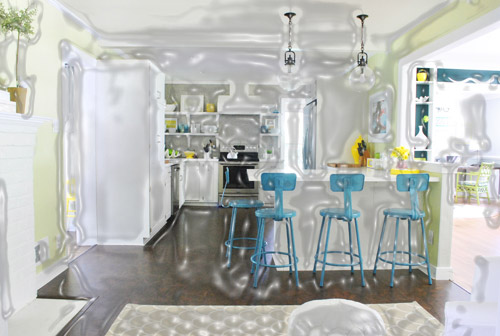
2. We’re not photography experts either: Besides some of the basic classes we both took back in school, most of our photography is self taught as well (Sherry took a photo class in college but claims only to remember how to develop film and nothing about actually taking photos). We’re still not that great at it – or at least not as good as we’d like to be – which is partially why we’re grateful to have Photoshop, which helps photos that might not really capture how something looks in real life, look more like they do in person. Since we’ve yet to find a camera with a “capture this shot just like my eye sees it” function, we mainly use Photoshop to fix that (so you guys get an accurate picture of what a certain project/room looks like instead of being limited by our not-always-stellar photography skillz). Maybe someday we’ll be able to post photos straight out of camera (SOOC as the cool kids say), but we’re not stressing about that since just about all of the pro photogs that we’ve encountered do some degree of picture editing.
3. Photoshop is not the only photo editing option: We use Photoshop because it’s what we’re both comfortable with and by general standards, it’s the most comprehensive and professional-grade photo editing tool out there. However, it’s not cheap (aka $700-not-cheap). It was a business expense for us (and it was something we used for years beforehand and knew we liked) but there are definitely cheaper alternatives for those who aren’t ready to fully commit. Adobe sells “lighter” versions of it, like Photoshop Elements ($100), and there are other options like iPhoto ($15) or Picasa (free) that can do some basic adjustments too. We’ve also heard recommendations for free software like GIMP and Picnik, which is now apparently part of Google+. We haven’t used those others (except for iPhoto, which we rely on to organize our pictures and do basic functions like straighten and crop – see below) so I won’t provide advice on those.
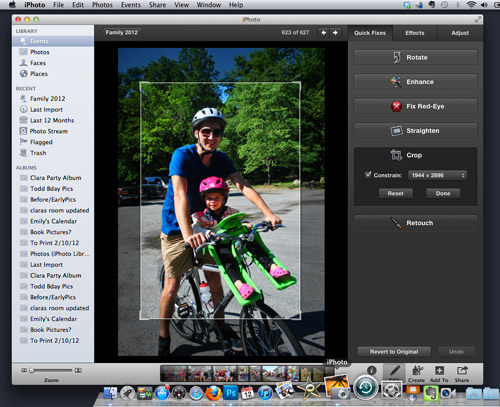
Now, on to the meat of this post. I thought I’d start off by showing you the basic editing adjustments that we use on just about every photo you see. Again, these aren’t major things like changing a wall color or removing Sherry’s sixth finger – they’re just the tweaks we make to what you see on screen look closer to what we actually see in real life. Let’s use Clara and her dollhouse as our subject. Here’s the SOOC shot:
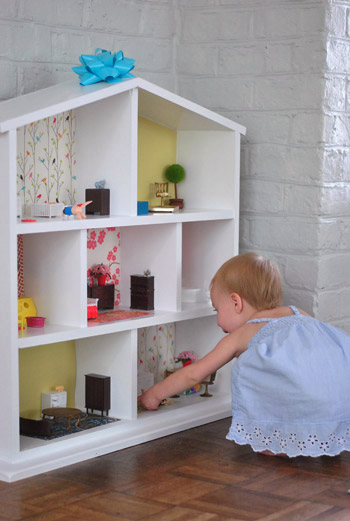
It’s not actually all that bad since our living room gets a fair amount of natural light and we remembered to white balance the camera before snapping the picture. But there’s still room for improvement so we open it in Photoshop.
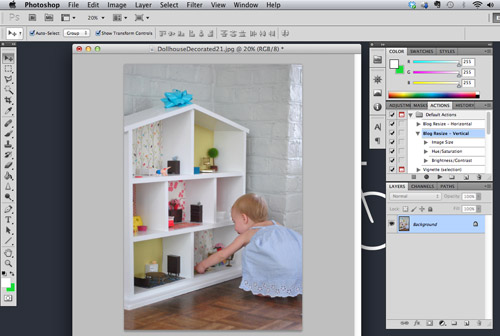
The first thing we have to do is resize the image, since what you see above is only 20% of the actual size. If we were to post pictures at 100% they’d look something like this and our blog would be slower than molasses.
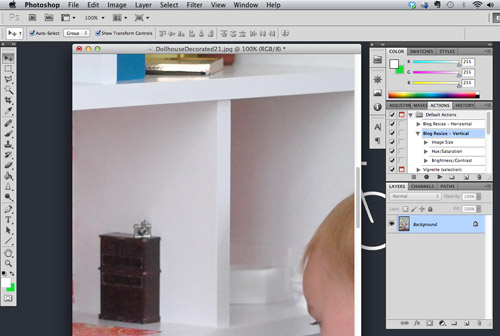
So we IMAGE > IMAGE RESIZE… (or Command+Option+I on a Mac) to resize it to 72 dpi (which is standard web resolution) and 350 pixels wide (which is the standard size we’ve chosen for vertical images on our site – horizontals are 500px). Be sure the “Constrain Proportions” box is checked so that Photoshop automatically adjusts both dimensions and you don’t end up with a weirdly stretched photo.
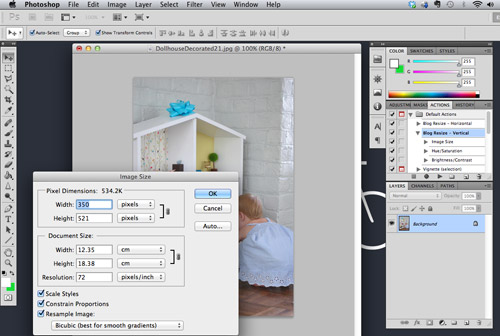
The next thing we do is up the color saturation a bit. This just makes the colors a bit more vibrant (they usually are flatter in photos and more vibrant in real life) and it can be found under IMAGE > ADJUSTMENTS > HUE / SATURATION… (or Command+Option+U). The adjustment shown below (+40) is more than we usually do (which is usually just +10) to help illustrate the difference. You can see the original picture at the left and the more saturated version on the right. But that’s way too saturated to look real, so we usually just do +10.
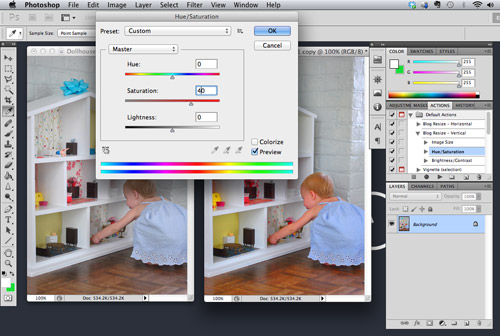
To keep the picture from looking too washed out, we also up the contrast which is found under IMAGE > ADJUSTMENTS > BRIGHTNESS / CONTRAST… (much to my annoyance, there’s no keyboard shortcut for this sucker). Again, we only do a +10 but I’ve shown a +50 below to make the effect more apparent. If you go too high the whites get washed out and corners get dark so again, just do what it takes to make the shot look more realistic, and don’t overdo it to make it look like crazyville.
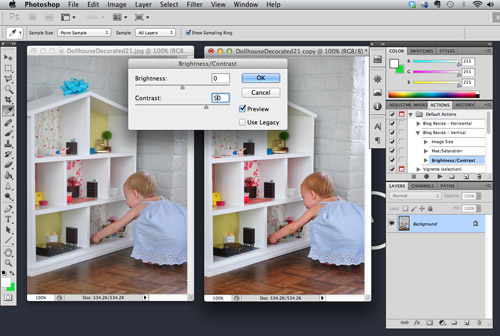
We found that these two steps help counteract some of the washing out that seems to happen when we reduce the file size for the web (more on that later) so we do them to every single photo we post. To make our lives easier we’ve created a custom Photoshop Action to do it all (plus the resize) with the click of a button. So for every photo we open, we either click “Blog Resize – Horizontal” or “Blog Resize – Vertical” (depending if it’s a horizontal or vertical pic) and these adjustments happen on autopilot.

To make a custom action, find your ACTIONS window (make sure it’s checked under the WINDOW menu if you don’t see it). Click the New Action button, give it a name, and then hit the record button in the window that will pop up. Now proceed with the actions you’d like to record. It will record just about everything (even if you switch windows) so be sure to make sure you’re only performing the actions you want to perform. When you’re done, just hit the Stop button and your action will be saved (you can add new steps to your action by hitting the round Record button again). Then when it comes time to apply your action to a particular photo, just hit the “Play Action” button and watch it happen.
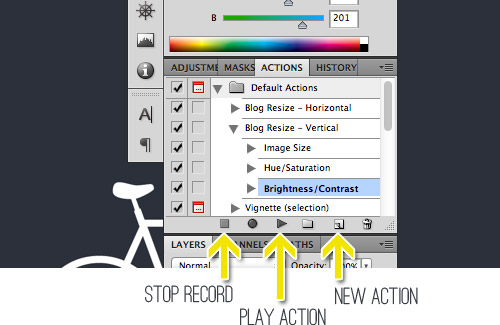
For about half of our photos, that’s all we need to do to make them web ready. Of course if we do an action and it looks less like real life we’ll just undo it and manually adjust, but most of the time it does the trick. We also might perform a couple of extra steps if the photo still doesn’t look as bright/balanced as it does in real life. The first thing we might do is adjust the exposure using the Curves function found under IMAGE > ADJUSTMENTS > CURVES… (or Command+Option+M). We just click and hold our cursor right in the middle of the diagonal line and drag it up a smidge (turning the line into a gently bowed curve). This adjusts the brightness of the photo while still keeping the darkest spots dark, which prevents it from washing out. That’s why we don’t use the Brightness function shown within the Contrast box mentioned above. Once again, you can overdo this if you pull too far, so we just go up a smidge and use “what it looks like in real life” as our guide.

The other thing we like to do to some photos is balance the color slightly. As we mentioned in this post, I’m a bit of a stickler for a photo’s color “temperature.” I prefer a picture to look as natural as possible, so I don’t like when it looks too warm (yellow-y red) or too cool (blue-y green). White balancing within our camera takes care of a lot of this, but it’s not a perfect system. So instead, I use the Color Balance tool (IMAGE > ADJUSTMENTS > COLOR BALANCE… or Command+Option+B) to even things out. This particular photo was looking a bit warmer than I liked (although it might be hard to see see the pinkish undertone of the white dollhouse at this size) so I slid the dial a smidge closer to the cooler colors (cyan & blue). It’s definitely a very slight adjustment and it’s not perfect, so when we have a couple dozen photos per post I’m not always a stickler or getting things ready for a post could take all day.
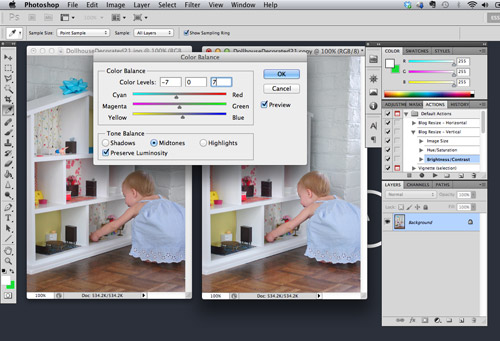
So here’s a side-by-side comparison of what all of those adjustments achieved. In this case it’s pretty slight, but sometimes we upload a photo that’s way too underexposed / way too washed out / way too warm / way too cool and we have to make some more dramatic attempts at getting it closer to reality. For those who don’t see much of a difference, try looking at the top right corner of the dollhouse. See how it’s bright white and not gray or sort of pinkish? Also see how that bright yellow/green paper in that corner looks vibrant (like it does in real life) and less muddy? And see how Clara’s hair looks more blonde with some red undertones and some brown undertones instead of flat light brown? It’s just a bit more like real lift in the picture on the right.
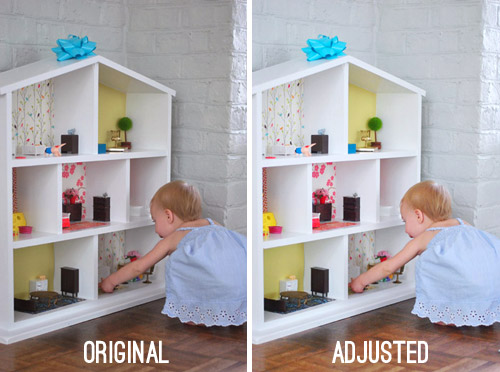
Oh, and the other thing that happens to all of our photos is saving it in a compressed format so that they’re small enough to load quickly. We use Photoshop’s built in function (FILE > SAVE FOR WEB & DEVICES… or Shift+Command+Option+S) to save them as a compressed JPEG. This step tends to reduce the color contrast on a picture, which is why we make some of the above changes in the first place.
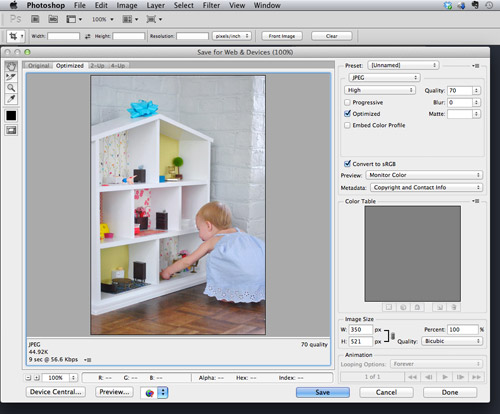
The steps above are by no means a perfect system – but they’re the system that we’ve developed to easily and comfortably get photos that we’re generally happy with. If you prefer your photos to have a different “feel” to them (maybe a warmer vintage look? maybe a more vibrant, high-contrast look?) then you’ll have to find the settings and adjustments that work better for you. Just play around and see what you like.
Now that you’ve seen the basic tweaks we make to just about every photo, let’s cover a couple of the more intricate things that we have to pull out of our bag of tricks on occasion too. The first is using Photoshop to help make design decisions. Let’s say, just for kicks, that we were contemplating a new headboard for our guest bedroom. We’d open a picture in Photoshop like the one below and start to futz around with it.
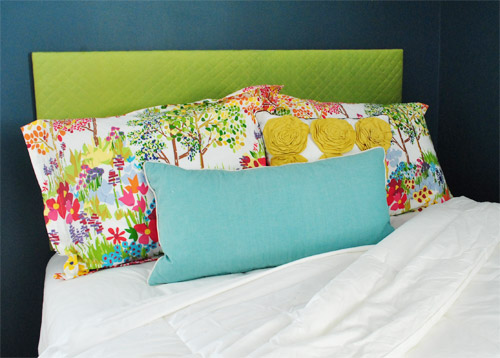
The first step is to highlight the area that you want to change. There are a few selection tools with Photoshop to do this, so I’ll start with the most basic lasso tool. This one is called the “Polygonal Lasso” because it draws straight lines between points you designate by clicking. It works well for the top part of this headboard because it’s simple straight lines. The goal is just to click to turn corners and sketch the line around the entire headboard perimeter so it meets up with itself (when it connects to itself on that last click it’ll flash and the area within it will be selected.
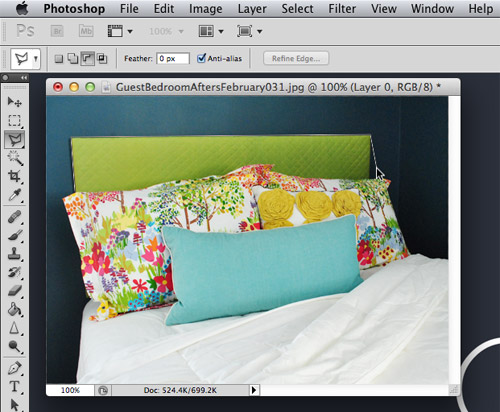
The Polygonal Lasso might get a bit tricky once you get down to the rocky edge of the pillows, which is why sometimes we rely on the Magnetic Lasso (which can be accessed in a drop down by clicking and holding over the same lasso icon on your toolbar). The “magnet” in this lasso is usually nice and smart about finding edges in your photo, so as you roughly trace the outline of your object it will snap to the edge. It’s not a perfect tool (especially in low-contrast areas) but I find it to usually be better and faster than free-handing it. So I’d just go around the whole perimeter, and meet up with my first point to select the entire headboard.
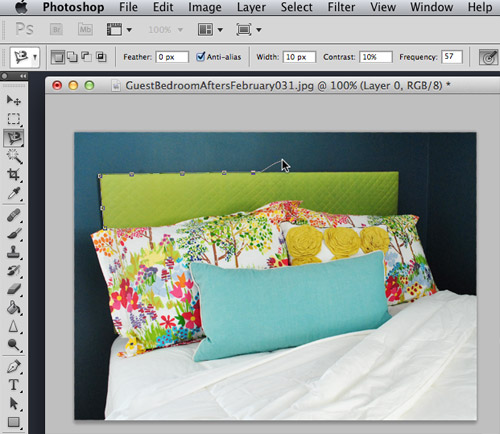
To demonstrate another tool, since our existing headboard is pretty much monochromatic, I can also use the “Magic Wand” tool to make my selection. It allows you to select an area of similar color (you adjust exactly how “similar” by moving the Tolerance number up or down). I kept it restricted to Contiguous color only, so it wouldn’t add greens from the pillows to my selected areas. One selection didn’t get it all in this case so I held down SHIFT and added the rest of my headboard with another click of the mouse in that area.
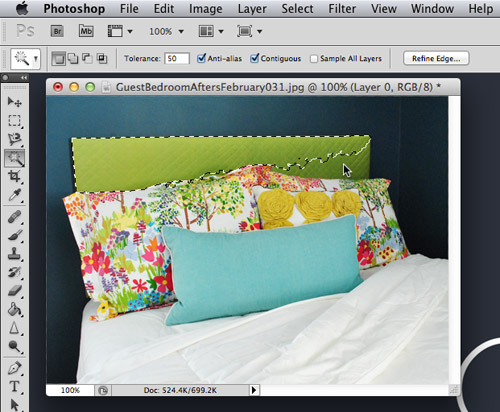
With the area selected, the fun can really begin! If we were debating a new color, we’d probably turn to the Hue/Saturation menu that was mentioned above (IMAGE > ADJUSTMENTS > HUE / SATURATION… or Command+Option+U). By dragging the cursor along the Hue bar you can shift the color to anywhere on the color spectrum. You can also use the Saturation bar to make the color brighter or duller and use the Lightness bar to make it darker or lighter.
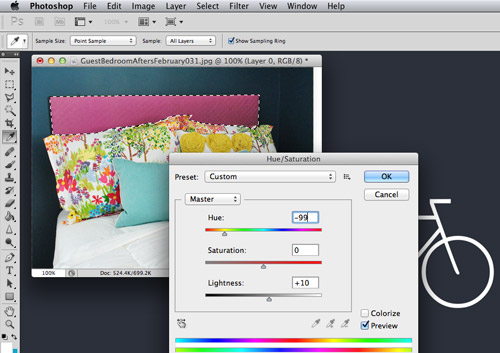
Another option is to create a new layer of color atop the existing headboard. This would make sense if our existing headboard was a crazy pattern or if we didn’t have any headboard at all. To do this I clicked the “Add New” button in the Layers tab (see bottom right below) and then used the Paint Bucket fill tool to add my new color. You want to do this in a new layer because if you tried to fill over the layer with your photo, you’d just end up filling any nearby pixels that matched the pixel you happened to click – instead of your full headboard area.
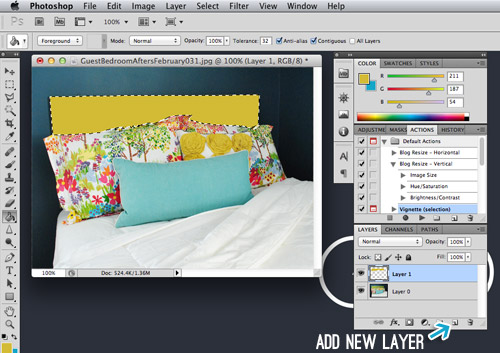
Now let’s say we wanted to add a pattern instead of just a solid color. I opened this photo of black and white stripes and dragged it into my headboard photo by clicking on the striped layer, holding my click and dragging it into the window with my headboard photo (you can see the ghosted icon of the stripe layer in the screen shot below, which shows until I release my click).

Doing the action above would just fill my entire photo with stripes. So to isolate it to the headboard area, we like using what’s called a Layer Mask. With my headboard area still selected, we just click the Add Layer Mask button (see the bottom right again) while having the striped layer active (sorry my screen capture shows the wrong layer highlighted). The Layer Mask basically hides all of the unselected areas and only shows the stripes in the area I had selected (aka the headboard). See the mostly black thumbnail added to the right of my stripes thumbnail in the bottom of the image below? That’s my Layer Mask – the black area is what’s hidden (or masked) and the white area is what’s visible to create the headboard shape.
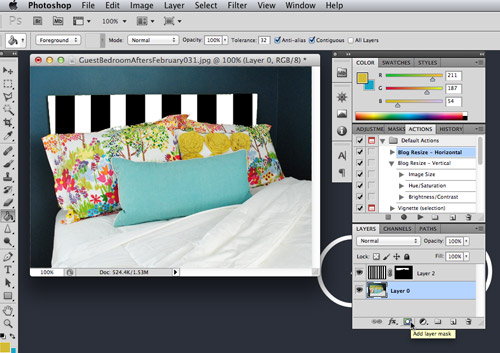
If you want to play with your pattern – shrink it, twist it, whatever – just “unlink” your image layer from the layer mask. You can do this by clicking the chain icon between the two layer thumbnails (where the blue arrow is pointing below). This allows you to transform your image while keeping only the headboard area visible.

The last trick we use when mocking up design decisions is to sometimes mess with the layer’s “Blending Mode.” There are a bunch of options that will appear in a drop-down at the top of your Layers menu. We just try a few to see if anything gives us an effect that we like. We find the “Multiply” tool to be most helpful because it tends to help your top layer blend with the bottom layer more naturally (for example, when doing Clara’s monthly photos we set the text layer to Multiply so numbers and the word “months” seems to be printed on the texture of her shirt more realistically than it does when it’s just placed on top).
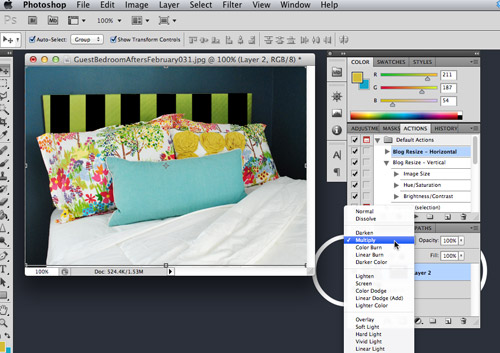
I’m not sure any of that exercise was really helpful in coming to a better headboard solution (we’re kinda cringing for the green and black guy above), but hopefully you get the idea of how you might be able to visualize different options within Photoshop.
This post has already been waaaaaay longer than I originally envisioned it, yet I feel like I’ve barely scratched the surface of what can be done within Photoshop. So perhaps if you guys have specific questions within the comments we’ll do a follow-up post with some additional information (probably can’t realistically explain much in the comments without visuals, etc). We probably won’t know the answer to everything though, so feel free to chime in to help each other (and us) out too. We’re always game to learn new things!

Roxanne says
This was a very helpful post! You guys teach me everything :) I had been meaning to learn a little more (ok, anything) about Photoshop and this has been super informative. Thanks!
Amanda says
Awesome tips! I’ll definitely be referring back to this once I finally get Photoshop. Just a quick question, right above the Clara picture that shows the original and adjusted, did you guys mean to say “like in real life” instead of “like real lift”? But maybe “lift” is some swanky photo-editing term that I just don’t know ;)
YoungHouseLove says
Hah- yes! Real life!
xo,
s
cara says
Thanks for the post. I love hue/saturation and use it to adjust a lot. I also like the filters. I’ve used it for design choices too, picking rugs or pillows, pot rack placement, etc.I had photoshop elements 4 forever then finally upgraded to 8. I now have 10 waiting to be installed on my computer. Do you guys calibrate your monitor? I have an imac and the screen seems bright. I got the eyeone calibration tool but have only tried it out once.
YoungHouseLove says
We actually don’t do it as much as we should. Things definitely read differently on Johns monitor and mine (his are generally much brighter and more saturated looking) so we can’t imagine how our pics must look on all monitors, I’m sure it really varies!
xo,
s
Julia @ Life on Churchill says
my husband I were just working on a poster, I added a plastic wrap filter and had a good laugh about how much I liked that filter in high school. nice post!
YoungHouseLove says
Haha, high fives for plastic wrap.
xo,
s
Lindsay says
Have yall ever used the “Levels” option for adjusting your photo colors to make them more true to what they are in real life? Through all of my photo classes, that is the tool that is supposedly the best. I like it a lot and it’s very simple.
YoungHouseLove says
We did use that but later developed a preference to use curves instead. I wonder what the difference is. We thought curves looked a little more natural or more subtle maybe?
xo,
s
pam says
I love the term ‘futz around’ :)
YoungHouseLove says
Haha me too. It made me laugh out loud while I was proofreading this. Haha.
xo,
s
ash says
thanks for the post. gives me courage to venture into photo editing.
YoungHouseLove says
Glad to help Ash! Good luck.
-John
Stephanie says
I liked this post, very helpful!
Did you see this article? Your “art gallery” is #5!
http://shine.yahoo.com/at-home/hall-fame-8-stylish-hallway-decorating-ideas-204100613.html
YoungHouseLove says
Thanks for the heads up!
xo,
s
Z says
how do you make the weeks/months circles on clara’s shirt look like they are attached?! specifically when her arm or another object is blocking part of the circle!
YoungHouseLove says
We rasterize that layer of type and then use the opacity tool to make that layer see-through so we can see an arm or leg that should be in front of it and use the erase tool on the translucent type layer to erase part of the circle or number to make it look like it’s under something. Then we bring the opacity back up and it looks like it’s behind something instead of just erased!
xo,
s
heyruthie says
This is a great post, John. In fact, it’s the second great “Photoshop Tips” post that I’ve read this month-one on another great blog.
This really makes me think that you (John) should host your (first ever?) linky party. So many self-taught photo editors have great “how I edit my photos” posts out there. I’m not talking about professions–just real-life bloggers who have found some “quick and dirty” methods of making their photos better. It would be great fun to have a link party where people post them for readers to take a look at. The collective knowledge would be awesome, because everyone’s sort of got their own tricks up their sleeves with Photoshop (or even other software!) I know a linky party doesn’t sound very “manly”–but I would be right there reading every single tip!!
YoungHouseLove says
That sounds really fun! I’ll have to see if I can organize something like that. Totally would be useful to have them all linked up in one spot!
-John
Sherry from BC says
I heartily second this too. Maybe you can call it a chain gang instead of a linky? Is that more manly? HEE! HEE!
YoungHouseLove says
Haha, nice.
xo,
s
LauraC says
“Chain gang” Snort! Wiping my eyes from laughing. hahahaha!
Christina says
Thanks for this post! This was super helpful and has inspired me (a poor education student married to a poor med-school student) to check out a few of the free options you suggested! I’m loving Picasa already and PicMonkey looks promising :) Thanks for the helpful tips…my pictures are looking better already!
YoungHouseLove says
Yay! So glad!
xo,
s
Wendy says
I always recommend Adobe Lightroom to newbies. It does all of those light and color, crop and resize edits (plus a few little extras) but is easier to figure out than Photoshop. It’s super easy. All the recolor/texture stuff you did in the last photo is a no go in lightroom though (at least as far as I know). But when you get one picture fixed, all you do is click copy and you can paste whatever adjustments you want onto other pictures. That’s my favorite feature!
You guys are really good at explaining it all. I’m impressed that you taught yourself so much in photoshop. I know from experience that’s tough (which is why I mostly use lightroom now! ha!)
Stacy says
Wow! I know a lot of people are saying this but even for us who use Photoshop everyday this was an excellent tutorial.
As for me I’m a Levels girl all the way. Pop open a levels adjustment layer and use the “eyedroppers” on the levels adjustment menu. Click the dropper filled with black on something that should be true black (your darkest shadow) and then click the dropper filled with white on the hottest highlight which should be true white (usually a light reflection). This has helped me quickly fix a zillion and a half pics.
The Curves menu, however, still scares me after a decade plus.
YoungHouseLove says
Haha that’s so funny because we used to be levels people and now we just pop open curves and drag up a little and we’re good! Haha. Will have to revisit levels!
xo,
s
Tyson says
Love the tutorial. I’m digging what I can see of your desktop wallpaper – a simple bike. Is this somthing you created? Where can I get it? Thanks!
YoungHouseLove says
That’s from simpledesktops.com (free!)
-John
Paola says
WOW!!! Thank you so much John for this post. It is colorful, easy to understand, and it made me play with my pictures right now!!!!
We have owned Photoshop and Elements for 2 years and had felt kind of intimidated to say the least of using them. My husband and I did the 52 weeks project for our Baby Victoria, inspired by you guys. Photoshop would had been useful you know, just the simple stuff our baby weekly picture required. My husband is going to love this tips.
Hopefully there is a follow up post!!!!!
Thank you again!
Ross says
I use GIMP on a regular basis and I find it is structured very similar to PhotoShop and has most if not all of the same tools and effects. So for anyone out there that does not want to drop the heavy price on PhotoShop or wants to try something similar I definately recommend this freeware.
Also, if you want to do some basic photo editing of random pictures, check out PicMonkey. We love using it to make pictures taken with our camera more special. http://www.picmonkey.com/#
heather says
If you shoot in RAW format (for anyone without Photoshop or Lightroom) and want a decent free editor, try RawShooter Essentials. It stopped being updated/supported in 2006 so you’ll get a notice every time it opens that it can’t register you (there is a way to get the program to bypass this, I’ve done it on my work computer, but not personal just google for it). Keep in mind this is just for easy processing, not resizing. I just do a batch resize out of a basic editor after.
I just received Photoshop back in my life after going about 3 years without it. Unfortunately it crashes my poor little computer if I try to do too much at once. I can’t wait to up it a little (or get a new computer) to really go crazy in it. I’m also looking forward to getting lightroom (someday!).
Betsey Hodson says
This is great! I’ve been a long-time reader of your blog (LOVE) and as a former photo editor, I totally appreciate your ability to sum up some of the Photoshop highlights so well and so clearly! Sure, it’s not everyone’s cup of tea but I know I’ll be referring people to this post in the future… mostly because I don’t have your ability/patience to summarize these handy little tricks :)
Crystal @ 29 Rue House says
Nice post John! And I really think it is a good primer for improving pictures (which I seriously need) that could be applied to probably any program.
Had my husband looking at your site with me last night and he thought you guys use special lights for picture taking. I don’t think you do but…do you or is it all your fantastic photoshopping skills?
Got any suggestions on how to fix grainy pictures?
YoungHouseLove says
We don’t use any special lights for our photos and actually try to take as many as possible using natural light (though on occasion we wrangle a bunch of floor lamps into the room we’re shooting in). The best tip I’ve got for avoiding grainy pictures (assuming you can’t get more light into your space) is to increase the exposure IN CAMERA. We use an exposure compensation feature on our Nikon to often up the exposure a bit as we’re taking pictures. That will help keep grain from getting into your photo in the first place. Just be careful not to overexpose because it’s hard/impossible to get area back if they’re just blown out to be all white.
-John
Crystal @ 29 Rue House says
When you say increasing the exposure in camera – that is the same thing as when I increase the amount of light allowed in (my point and shoot camera goes up/down points making the picture brighter or darker), right? I play around with that a lot and whether I use a flash. I probably need to always use a flash (because your right and I can’t get more light in) but then use your tips on fixing the picture in a program to make it look more real life.
Thanks for your help! You’re the best!!
YoungHouseLove says
Yes, that’s what we mean by exposure! We’re still learning about it, but generally using a tripod, turning off the flash but upping the exposure, and lowering the F-stop results in a crisp photo in lower light.
xo,
s
heather says
If you have a DSLR you can play with manual shooting and set the ISO (film speed). The higher the ISO number the more light into the camera but the grainier it will be. I try and stay on 200 as much as possible. I haven’t found there is much in post-op you can do to fix grain.
This is a better way of explaining how ISO, F-Stop and Shutter Speed work together:
“In photography, the size of the stream of the water is analogous to the f/stop, the length of time you pour is analogous to the shutter speed, and the size of the bucket is analogous to the film speed. Broadly speaking, from the bucket’s point of view, it doesn’t matter which combination of stream size and length of time you choose as long as the right amount of water ends up coming in.”
YoungHouseLove says
Great tips Heather!
xo,
s
Jan says
Wow, what a great post! Really useful :)
Nichole says
I’m in marketing/communications and do ALL of the graphics for my work, as well as for fun home projects. I use Photoshop every day and I STILL learned several new tricks from this. I appreciate seeing the behind-the-scene stuff for ALL of your projects, even if you’re just doing photo fixes. Thank you and keep ’em coming!
Kacie // A Collection of Passions says
This is so incredibly helpful! I just started with Photoshop CS4 and there’s a lot to learn. I am a pro photographer and have used Photoshop Lightroom for years. It’s another less expensive option that works great for basic toning and cropping and spotting etc.
Kacie
http://www.acollectionofpassions.com/
Shannon says
Thanks for the tips – very helpful!
Brittany P says
Excellent and easy-to-follow post! Thanks so much for sharing the tricks you guys have learned so far!! I’d love to see more tips and tricks on this subject, like how you guys isolate objects from other photos to make a Mood Board and how you layer all those objects into one cohesive image. Keep up the great work! And happy deck building. :)
YoungHouseLove says
That sounds like a fun one too! Thanks for the requests guys! We’ll try to do a few more photoshoop tip posts along the way!
xo,
s
Sherry from BC says
OOh….I want that too please! Always wanted to try that.
eRin @ growing up senge says
This is super helpful. This totally covers all the major things I’ve been wanting to do (resize for blogs, test out new colors) but haven’t had the time to mess with and look up online! As always, you guys are awesome…
YoungHouseLove says
Yay, glad to help!
xo,
s
Wendy says
Thank you for the warm and friendly manner with which you communicate. Being realistic with your ability to answer questions in the comments section and inviting others to help is a great gift to the world!
As it’s the end of the school year (Summer Rocks Tomorrow!) it’s ever more apparent how far a little kindness with clear expectations can go.
(Like with my 8th graders today who were complimented several times for being model kids as they waited 1 hour for the Kings Dominion trip to get underway. All because they knew what was expected and I politely updated them when possible.)
Thanks for being the positive examples that you are no matter how big or small… words are more than size!
YoungHouseLove says
Aw thanks Wendy, you’re so sweet!
xo,
s
Ryan says
I get why you only use Photoshop (one expensive piece of software is enough, right?) but I think you’d love Lightroom. It has some really sexy photo editing features. Plus it’s only $100 with an education license. I use that, along with Gimp, instead of Photoshop. I just couldn’t keep shelling out the big bucks for updates anymore.
Anyway, great post! I’d recommend giving Lightroom a go if you ever decide to use something more geared specifically to photo editing.
YoungHouseLove says
We have heard such good things about Lightroom we’ll have to try it!
xo,
s
Amy Knisely says
I *love* Photoshop! I use it for work every day to edit the photos I take for the newsletter I do. I have the entire Adobe Suite and use InDesign just as much (if not more). Very awesome products! It’s hard to become a “master” at them, but very basic stuff isn’t terribly difficult. Although when I learned how to use the cloning tool it was like a whole new world opened up. :) Thanks for the tips!
Jessica says
I found this on pinterest, and the deer head reminded my of your house! Random, but wanted to share :)
YoungHouseLove says
So cute!
xo,
s
Naomi says
Wow! You guys are really good at Photoshop. I need to learn more about all that stuff :)
-Naomi {Starry Eyes + Coffee Cups}
holly says
this was actually REALLY helpful. I would definitely like more posts like this in the future. Photoshop does so much that I often don’t know where to start learning.
Thanks!
YoungHouseLove says
Thanks Holly! Glad you liked it.
-John
Sherry from BC says
Love this post. Can’t wait to get home to try some of it. (I am on lunch at work)
I do toy with photoshop but the quick tips will really help. Will definitely be playing when I get home.
Krista Mac says
I am a big fan of pixlr.com for photo editing. It has the same set-up that Photoshop has but is web-based and FREE!
Great tips in this post! Thanks!
Danielle says
I’ve been using photoshop cs3 for a few years (just as a hobby), and I keep finding new and awesome things to do with it. Thank you so much, I learned some awesome tricks from you all!
Ashley Ez says
I just quickly browsed the post…but am super surprised yall don’t use Adobe Bridge to quickly get all of the photos to a common point before you start in on more in depth editing. It comes for free with PS and is a serious game changer. You can set up something similar to PS actions in Bridge and then mass apply them to all of your photos at once, then open them with the changes in PS to touch up further.
Plus, in Bridge you can custom white balance, which I think would really help yall out with color matching instead of explaining how something looks a little different in real life.
And finally….you can QUICKLY resize all of your photos (jpg, psd, pdf…) at once for the web in Bridge under tools..photoshop..image processor. There is a button that says “Resize to” and you put in your max pixel width and height and it zooms through all of the photos you selected and creates an output folder for you.
You both seem excellent at being self taught, with what you know about PS I’m sure you can quickly pick up on Bridge which works together in & with PS.
YoungHouseLove says
Sounds really smart! Thanks for the tip, we’ll have to try it out!
xo,
s
Amber says
You guys have no idea how perfect timing this post was! I have been scratching my head for weeks trying to figure out if I needed to get Photoshop, or Photoshop Elements, or Lightroom, or what! This has helped me definitely see that Photoshop is amazing, but I think its capabilities are a little beyond what I need. I think I’m going to just settle for Lightroom for now, but you have NO idea how helpful this post was for me. I have been scouring the internet all day looking for pictures that showed what photoshop does and what in the heck masks and layers are!! (You can see I don’t need a program as advanced as photshop lol)
Thanks guys! I know this post probably took forever to write but I sooo appreciate it!
YoungHouseLove says
Happy to help Amber! Good luck with everything!
-John
Koliti says
I think you now have given away all your secrets of how you keep your house looking so clean! (HaHa – if ONLY we could take a pic, Photo Shop it, and bada-bing bada-boom it became real).
Hey John, if Sherry should happen to plastic wrap something…you can use your Dremel Multi-Max to open it :)
I will echo an earlier poster’s (Monica’s) comment – I took graphic design classes at my community college (apparently before on-line classes and Amazon became so popular, ahem) and was able to purchase the set of Adobe PhotoShop/Illustrator/InDesign at at least half off at the college bookstore with student ID. Take a class (whether for credit or audit) and take advantage of a savings opportunity.
Also (for those not familiar) you don’t need to know shortcuts before hand – when in the Photo Shop program, when you click on a tab and it brings up the drop-down menu – it will list shortcuts to the right of your selection.
John, all of your information is beautifully presented and greatly appreciated.
YoungHouseLove says
Great tips Koliti! Thanks!
xo,
s
Crystal says
I love reading how others edit their photos…always can learn something new. I am one of the many that would love to own photoshop but not willing to dish out the $700. My laptop came with Corel Paint Shop Pro X3 and I started playing with it and to my surprise I can do almost everything photoshop can! I don’t think Paint Shop Pro gets the credit it deserves since Photoshop dominates the market. After self teaching myself Paint Shop Pro, I tried a free version of Photoshop Elements and quickly decided Paint Shop was for me. For those that would love the capability to edit photos like Photoshop but can’t afford the pricetag they should seriously consider Paint Shop Pro x4 (the newest edition). It runs less than $100!!! Just a tip…
YoungHouseLove says
Great tip Crystal!
xo,
s
Shay says
I love when people share their secrets!
Two things; when editing a photo it’s helpful to resize last instead of first. That way you aren’t loosing detail while you do your edits. ;)
Secondly I am a huge fan of Light Room (by Adobe) and I didn’t see it mentioned. It’s like a photo only version of Photoshop. I’ve always had a hard time remembering how to use PS and get frustrated; I find LR much more straightforward and intuitive. Also there is a huge price difference! Light Room is $150. My husband now buys me upgrades for a present because I’m so reliant on it.
I highly recommend giving the demo a try.
YoungHouseLove says
Great tips Shay!
xo,
s
Paula M. says
I *LOVE* this post, plus some of the additional reader tips in the comments section as well.
As usual, YHL’s post is thorough, clear, informative and personable. This info will be helpful in both my personal AND professional life (web editing work).
(need I add that I have bookmarked this already?)
You two are the best (insert hearts and flowers here)!!! (Don’t let anyone tell you different)
YoungHouseLove says
Aw thanks Paula!
xo,
s
Kelsey says
Pixlr.com is a good one too. It’s a free online editor and it really easy to use for minor photo edits.
YoungHouseLove says
Great tip Kelsey!
xo,
s
Amy says
Another software option is Adobe Lightroom. It will perform most functions of Photoshop that are used for photos– curves, levels, saturation, etc, and has other modules such as photo organization, leaving Photoshop for the big guns (extreme modification, touch-ups, etc). It’s also much cheaper than Photoshop and for a lot of professional photographers, it’s all they use.
Do you shoot your images in RAW first? Changing things and getting it true(r) to life can be much simpler if the image is shot in RAW and processed in Photoshop’s Camera RAW or in Lightroom. You said you compress it to JPEG so maybe you do, but even when I’ve shot in JPEG I’ve compressed the picture further before posting. Original quality JPEGs are huge!
YoungHouseLove says
Yeah, we don’t usually shoot in RAW since we don’t have space to store as many photos like that, but when we’re taking photos for something major (like a before and after story in a magazine) we will! It’s definitely a lot more data to work with!
xo,
s
Shanna says
Thanks for this post. I don’t currently use Photoshop, but I do know that it takes a lot of time to create documentation that shows people step-by-step how to use software or complete specific tasks. I really appreciate all your hard work, and I hope you continue to post in your thorough, zany, funny style. :)
YoungHouseLove says
Aw, thanks Shanna! You’re sweet.
xo,
s
Anne says
Golly, John, that was a lot of detail, and I really appreciate it!! I have always wanted to learn more about Photoshop, especially for design decisions. I saw this post in my FB feed and got excited, lol! Thank you for taking the time to do this!!
YoungHouseLove says
You’re welcome Anne! Glad to help!
-John
Meena @ Little Dinos says
Thanks for all the nice tips. I am also self-taught like you and never thought of using actions to setup a basic work-flow. Will be working that into my process :).
Shannon says
I’m a self-taught photoshopper, and learned a few new tricks from your post. Thanks so much for taking the time to explain it so well! It can definitely be a tricky program to figure out, and you did a fabulous job of making it seem so simple.
tracey says
Not sure if anyone has suggested it, but all of those functions can be done by clicking the little half white half black circle in the bottom of the layers palette. This enables you to mask off areas that you don’t want affected by the treatment and also to undo, stack and change the treatments as you go- i love non destructive editing. :) xx
YoungHouseLove says
Thanks for the tip Tracey!
xo,
s
Ceara oconnell says
I’m sure I am way too late for you guys to even read this, and it’s probably been said, but I just wanted to say how much I appreciate a post like this – not many people would take the time (and lots of it) to put something this user friendly together for something as often intimidating as photoshop just to help your readers. You guys did a great job and honestly the before and after screen shots are have explained things I’ve never really understood about photoshop. Thanks.
YoungHouseLove says
So glad! Thanks so much for the kind words!
xo,
s
Morgan says
So thrilled you posted this! I use photoshop everyday for work and personal/blog pics and I learned a few great tricks here! I’ve never bothered to create actions (though I use others that I’ve downloaded) off to create a few!
Do you have any favorite actions? Other than the Pioneer Woman actions you’ve mentioned before?
PS knocking the ‘Offset’ in Exposure down just a wee tad has been a favorite move lately, and I also hate that brightness/contrast and crop do not have shortcuts!
YoungHouseLove says
I think the ones we have mentioned before (from PW) are some of our favorites other than ones we make for resizing and brightening/color correcting! Anyone else have favorite actions they’d like to share?
xo,
s
Danielle says
Thanks so much for the great info! I took a Photoshop class at a local community college, but it was a couple years ago and I don’t remember as much as I’d like. Thanks for the refresher that I’ll definitely be bookmarking!